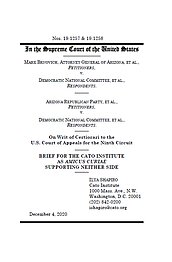Learn more about Cato’s Amicus Briefs Program.
The journey to secure the right to vote has been hard-fought. The Voting Rights Act of 1965 (VRA) marked a historic occasion in that struggle, as African Americans and all citizens were provided a tool to protect their rights as voters. Since its passage, states have been tasked with regulating elections—a task the Constitution has always left them to them—while ensuring the individual’s right to the ballot box.
Prohibiting all voting procedures that discriminate on the basis of race, ethnicity, language, or other minority status, Section 2 of the VRA has historically been used to challenge redistricting schemes that dilute minorities’ voting power. Since the Supreme Court’s decision in Shelby County v. Holder (2013) disabled the Section 5 requirement that certain states—largely in the old Jim Crow South—“preclear” all electoral changes with the Justice Department, Section 2 claims have shifted toward their original purpose: challenging laws that allegedly deny minorities the right to vote and stifle their participation in the voting process
In 2016, the Democratic National Committee sued Arizona over two of election regulations many states have: (1) in-person voters must cast their ballots in their assigned precinct, and (2) third parties can’t collect (“harvest”) ballots, with some narrow exceptions. More consequential than settling a dispute over Arizona law, however, this case highlights the ever-increasing trend that each election cycle is accompanied by a wave of litigation aimed at dismantling state laws.
Fueled by more than mere partisan or ideological disagreement, litigation arises from the lack of clarity surrounding Section 2 jurisprudence. Supreme Court guidance has previously only touched on vote-dilution, leaving a haze over the proper analysis for vote-denial challenges. Disputes over the proper evidentiary standard necessary to establish a discriminatory burden remain unanswered, and this lack of uniformity has led to virtually identical laws enjoined in some states and upheld in others. With at least three different frameworks for evaluating vote-denial claims arising in around the country—with differences within circuits, not just between them—states find themselves trapped between a rock and a hard place. Unable to comprehend what would satisfy Section 2’s requirements, legislatures are left unable to make electoral reforms without an unending cloud of legal uncertainty.
Cato has filed an amicus brief in the Supreme Court supporting neither party but urging clear rules that will guarantee the rule of law. Arizona’s laws seem constitutionally kosher because they are not aimed at disenfranchising anyone, but regardless of whether the Court upholds them, it should lay out a manageable rubric to ensure that judges, legislators, and citizens alike properly understand Section 2’s protections. Section 2 cases rarely come to the Supreme Court because intervening elections or internal pressures lead states to amend their laws, so it’s crucial that the Court take this opportunity to set workable standards. After such a contentious election that has highlighted certain weaknesses in state election regimes, the need for precise rules has never been more apparent.

This work is licensed under a Creative Commons Attribution-NonCommercial-ShareAlike 4.0 International License.

